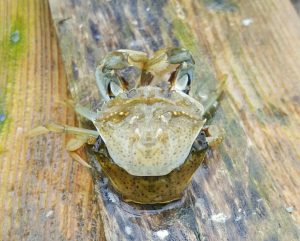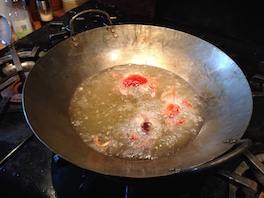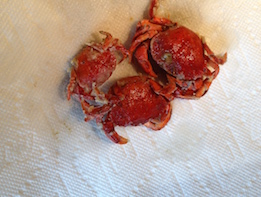Investigating the viability of a soft-shell green crab industry in Maine
NOTE This blog post was written by Marissa McMahan, a graduate student at Northeastern University, working on a Sea Grant funded project to explore the potential for a soft-shell green crab seafood industry in Maine.

The idea for this project began with a conversation at a Christmas party last year. A friend of mine, Jonathan Taggart, had recently spent time working in Venice, Italy, and was incredibly excited to share his experience with Moeche, a soft-shell crab that is closely related to our own invasive green crab, and can be found deep fried in many restaurants in Venice. Moeche is considered a delicacy, and the artisanal fishery provides a supplemental income for fishermen who catch the green crabs as bycatch in their nets. The entire fishery revolves around the fishermen’s ability to detect when the crab is about to molt by looking for signs on its shell. Molting is the process by which crustaceans grow, and involves the crab shedding its hard external shell to reveal the gelatinous new shell it has grown underneath. The crab will eventually fill into the new shell, which is larger than its old shell. During this stage, the crabs are incredibly soft, and perfect for frying! They are prepared much like soft-shell blue crabs in the mid-Atlantic and southeastern U.S., and are highly sought after in northern Italy.
After this initial conversation, I started talking with local fishermen, including my father, Jim McMahan, and my partner, Chris Jamison. There seemed to be a good deal of interest in exploring whether or not a similar fishery would be possible in Maine. Green crabs (Carcinus maenas) are an invasive species in the U.S., and they have been linked to the decline of soft-shell clams and eelgrass. They also compete with our native crabs, and possibly even lobsters. So it’s not surprising that fishermen want to get rid of them, or at least reduce their numbers. Many attempts have been made to mitigate the harmful effects of green crabs, including bounty programs that reward fishermen by the weight of green crabs they remove from the water, and netting or fencing projects that aim to protect vulnerable soft shell clams. However, targeting green crabs for profitable culinary purposes seemed like a novel idea.
Jonathan and I did some digging and found that green crabs had been used by a few chefs in Massachusetts for making stock, but that the practice hadn’t really taken root and spread. We also found that a graduate student at the University of Prince Edward Island, Luke Poirier, had been investigating harvesting soft-shell green crabs. Luke had actually traveled to Venice and worked with several crab fishermen to learn their techniques. He brought this knowledge back to PEI, and is now helping to build a soft-shell crab industry on the island. After several conversations with Luke, we decided this was definitely something that we could replicate in Maine. I applied for, and received, Maine Sea Grant Program Development funds to research green crab molt patterns in midcoast Maine.
Simultaneously, Jonathan traveled back to Venice and spent two weeks working with local fishermen and learning to identify pre-molt crabs.
Since early June, we have been trapping green crabs in two locations in Georgetown, Maine, in an effort to determine local abundance, distribution, size frequency and molt patterns of green crabs. We recently added an additional location at the mouth of the Kennebec River.
We have found that green crab populations differ drastically, even across distances spanning less than a mile. We have also been observing caged crabs in these areas, in an effort to identify pre-molt signs. Most importantly, we harvested, cooked, and ate a small batch of soft-shell crabs in late June, and they were delicious! Tender and juicy on the inside, crunchy on the outside… it’s no wonder this is considered a delicacy! Although marketing this product is not in the immediate future, hopefully its crunchy fried goodness will lead to widespread demand and eventually a premium price.


Creating a fishery for green crabs will depend on the involvement of the fishermen and communities who would potentially benefit from such an industry. Thus far, I have relied heavily on the local knowledge of fishermen in the Georgetown area. They have been a key part of the success of this project, and I will continue to seek their opinions and involvement as the project progresses. In addition, part of the Sea Grant funding I received was dedicated to engaging students from the Georgetown Elementary School in green crab research. In May and June, I visited the fourth grade class and taught them about local ecology, invasive species, crab biology and how climate change impacts local patterns and processes. We discussed ideas for managing invasive species, including creating a green crab fishery. Students also performed a hands-on activity where they practiced measuring, sexing and describing live green crabs, and then individually marked them and released them into the classroom’s 300 gallon salt water aquarium. The students followed these crabs over the course of several weeks, noting any interesting biology or behavior. The exercise culminated with a field trip to the rocky intertidal, where students identified native and invasive marine species, and practiced using quadrats to measure the density of crabs and lobsters. The project was a huge success! The students were engaged, inquisitive and incredibly insightful as to the physical and behavioral processes that structure the intertidal zone. Many of these students are children of local fishermen, and the future of local fisheries may very well rest in their hands. At the very least, they gained knowledge of their local ecosystem, and their own personal ability to be marine stewards.
Marissa McMahan is a Ph.D. Candidate in Jonathan Grabowski’s lab at Northeastern University. She received her M.S. in Marine Biology from the University of Maine, and has spent much of her life lobstering with her family in Georgetown.
